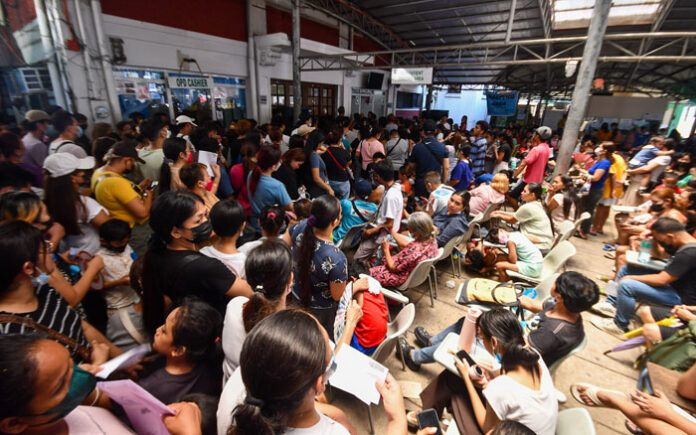DOH chief cites 500% hike in cases among 15 to 25 years old
- 2k bite patients daily at San Lazaro
- Pakil emergency state over dengue
THE Department of Health on Tuesday warned of a looming “public health emergency” as HIV infections have soared this year, with cases involving individuals aged 15 to 25 up by 500 percent.
Aside from the surge in HIV cases, the DOH is also addressing other public concerns such as increases in dengue and rabies cases as well as misinformation on monkeypox cases.
“Our biggest problem isn’t monkeypox but the spread of HIV. We’ve seen a 500 percent increase in HIV cases among those aged 15 to 25. In fact, the youngest person we’ve diagnosed is a 12-year-old from the province of Palawan,” Health Secretary Ted Herbosa said.
Asked to clarify the 500 percent increase, DOH Assistant Secretary Albert Domingo said the figure represents the new HIV infections for those aged 15 to 25 within a 10-year period from 2013 to 2023.
On average, 57 new cases a day were tallied in the country of 117 million people over the first three months of 2025, a 50 percent jump from a year earlier, with young males especially hard-hit.
“We now have the highest number of new cases here in the Western Pacific,” Herbosa said. “What is frightening is, our youth make up many of the new cases.”
“It would be in our interest to (declare) a public health emergency, a national emergency for HIV to mobilize the entire society, the whole of government to help us in this campaign to reduce the number of new HIV cases,” the Health chief added.
The health department said 95 percent of newly reported cases were male, with 33 percent aged 15-24 and 47 percent aged 25-34.
If left unchecked, Herbosa said the number of people living with HIV in the country could surpass 400,000.
The DOH did not explain the causes behind the surge, which it said had set back government attempts to hit global targets set by a United Nations campaign to end the AIDS epidemic by 2030.
Under Philippine law, the president can declare a health emergency if an epidemic poses a threat to national security. The start of the COVID-19 pandemic in 2020 was the last time that was done.
Warning against rabies threat
The threat of HIV surge is not the only concern being addressed by the DOH.
Since last week, the San Lazaro Hospital in Manila said it has been treating up to 2,000 people daily at its Animal Bite and Treatment Center as concern over rabies intensifies across the country.
While the DOH said there was a 32 percent drop in rabies cases from January 1 to May 17 at 124 cases from 184 recorded during the same period last year, the threat remains serious.
The DOH said all 426 reported rabies cases in 2024 were fatal.
“Even if the number of cases is low, rabies is devastating because once you’re bitten by a rabid animal and symptoms appear, the fatality rate is extremely high,” Domingo warned.
Central Luzon recorded the most cases so far this year with 21, followed by Zamboanga Peninsula with 15 and Calabarzon with 12.
Public hospitals and health centers nationwide are now offering free anti-rabies vaccinations and animal bite treatment, Palace Press Officer Claire Castro said.
“If you are bitten or scratched by your pet dogs or cats and are concerned about rabies, vaccination is free at government hospitals…For those going to private hospitals, PhilHealth has an animal bite treatment package,” Castro said.
Rabies remains a global health concern, with an estimated 60,000 to 70,000 deaths annually. The Philippines ranks sixth worldwide in terms of rabies incidence, according to PhilHealth, which recently raised its Animal Bite Treatment (ABT) package from P3,000 to P5,850.
Dengue on the rise, too
Meanwhile, local government units continue to address the rise in dengue cases, with the town of Pakil in Laguna the latest to be placed under a state of emergency.
“This will hasten our purchase of additional materials such as misting and fogging machines, and the chemicals needed to counter these mosquitoes that carry dengue,” Mayor Vince Soriano said.
LGU data showed from January to June 2, 2025, a total of 29 dengue cases were recorded in Pakil, most of whom are children.
“The surge in the number of cases was too fast in the past 10 days,” the mayor added.
In April, Herbosa warned the country may face a dengue outbreak this year after 76,425 were recorded from January 1 to March 15, 2025, much higher than the 42,822 cases during the same period last year.
“Our dengue cases increased by over 75% compared to last year. Because of this, we expect an outbreak this year,” Herbosa said in a previous interview.
“We have a dengue outbreak every 3 to 5 years. Our last outbreak was in 2019. We are expecting a big outbreak, and it’s most likely to happen this year,” he added.
The DOH, however, said the case fatality rate or the number of people dying from dengue remained low at 0.41 percent.
Fighting monkeypox misinformation
The DOH has also been battling false information on monkeypox with the proliferation of baseless warnings of a possible lockdown on social media.
“There is no reason to have a lockdown,” Herbosa said, emphasizing that mpox is primarily spread through skin-to-skin contact, unlike airborne diseases such as COVID-19.
The Philippine Society for Microbiology and Infectious Diseases Inc. added that wearing a face mask will not prevent the spread of mpox.
“Mpox is not known to be transmitted by the airborne route, for example, through the air across rooms, marketplaces, offices, and even inside planes. Hence, compulsory masking in these areas or within the broader community is not necessary,” PSMID said in a statement.
The DOH said mpox cases went down in May compared to the recorded cases in April.








